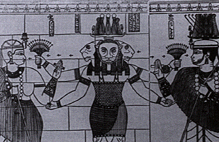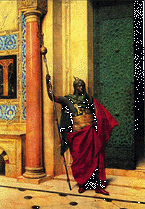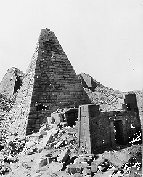
NUBIA


Located in today's southern Egypt and northern Sudan was most probably the oldest cultural complex in Africa. Known as Nubia, "The Land of Gold," to Egypt, the people of this land first called their civilization Ta-Seti, "Land of the Bow." Named so for its famous archers, Ta-Seti was a land of natural wealth, of gold mines, ebony, ivory and incense which she traded heavily with her neighbors.
|
CHRONOLOGY OF NUBIA
3800-3100BC Ta-Seti
2300-1550BC Wawat
2000-1550BC Kerma
1950-1100BC Under Egyptian Rule
747-200BC Naptan Kush (Nubian rule of Egypt)
200BC-300AD Meroitic Nubia
350-300AD The Noubadian Kingdom
550-1400AD Christian Nubia

I. REEVALUTATING KUSH
Nubia is probably one of the most underreported cultural complexes of antiquity. In the ongoing attempt to minimize the African involvement in such regions, even the inhabitants of Nubia sometimes fall prey to the Mediterranen Race Myth. (See
Egypt page for more on Hamitic Hypothesis). When this is not the case, Nubia is minimized within the Nile Valley as a purely Egyptian cultural invention. This has been the case so much so that some researchers have come to call Nubia, "the other Nile Valley kingdom." Often the myth portrays Egyptians as "superior whites" ruling over the more "primitive Blacks" to the south. In reality however, while Nubia and Egypt did war with each other, there were more years of peace than battle. These conflicts were usually territorial or economic and never racially motivated as certain Egyptians and Nubians obviously shared similar physical features. The victors were more often the larger kingdom of the Egyptians but sometimes the Nubians as well. A closer look at Nubia reveals startling information. Below are some revelations which have come from reevaluating Kush. |
Egypt's Dynastic rulership may have originated in Ta-Seti, thus signaling the first such form of government known to mankind.
The idea of a pharaoh (king) may have come down the Nile from Nubia to Egypt (and) that would make Nubian civilization the ancestor of Egypt's...
Dr. Bruce Williams, Archaeologist |
Egypt referred to its southern regions as Upper Egypt denoting its affinity with Kush.
The Southern Kingdom, Upper Egypt, was clearly conceived as the dominant of the two regions. It was from the south that the most enduring influences in Egyptian society came and without doubt most of its greatest leaders were southerners too. Through her long history Egypt constantly needed to return to the south to refresh herself and to restore her institutions, even perhaps her soul, when the weight of years or of external pressures laid too heavily upon her.
Micheal Rice, Historian |
Egypt was believed to have been a colony of Kush in antiquity.
They (the Ethiopians) say also that the Egyptians are colonists sent out by the Ethiopians, Osiris having been the leader of the colony... And the larger part of the customs of the Egyptians are, they hold, Ethiopian...
Diodorus Siculus, Ancient Greek Historian |

II. QUSTUL: THE WORLD'S FIRST MONARCHY
 This decoration of an incense burner found at Qustul depicts a sacrifical procession and the definite image of a king who wears a conical white crown and falcon-label. A cemetery of large tombs containing evidence of wealth and representations of the rulers and their victories was found at Qustul. If datings are correct, these finds are some 200 years older than the founding of Egypt's first dynasty, founded by Narmer (Menes), and represent the world's first monarchy. Many have speculated that what the Egyptians had said about "entire dynasties existing before Narmer" may be true. If this is the case then Qustul in Nubia could well have been the seat of Egypt's founding dynasty. (Photo courtesy of Lost Pharaohs of Nubia)
|

III. FAMOUS FACES IN KUSH
 | Queen Amentari and King Netek-amen worshipping the three-headed lion diety Ampedak. In Nubia many Queens often reigned in co-rulership with their husbands. In the case of the Candaces, or Kentakes, they were powerful queens in their own right. (Photo courtesy of Nubia) |
 A Nubian princess at the Egyptian royal court in her Ox chariot dated around 1320BC. (Photo courtesy of The Ancient Egyptians) |
 | Shabaka was the brother of Piye, the Kushite king who conquered Upper and Lower Egypt reestablishing central authority in the politically unstable land. It should be noted that the Egyptians did not treat these Nubians as foreign invaders but rather as close allies; the vast similarities in culture would readily explain this. Though Piye chose to govern from Kush, Shabaka instead completed the total reunification of Egypt and ruled from Waset. It was during this time that the then already ancient religous doctrine, The Memphite Theology, was copied onto a granite stone. (Photo courtesy of Ancient Egypt) |
 | Taharka is probably one of the most famous rulers of Napatan Kush. He was 32 when he became king and was heir to a kingdom that included not only Kush but Egypt as well. He is said to have commanded military campaigns in Western Asia as far away as Palestine and expeditions all the way to Spain. Taharka's great accomplishments were overshadowed however by constant aggression by neighboring Assyria. Though his battles to save Egypt from Assyrian domination were eventually unsuccessful, he did wage a relentless struggle from 677 to 664BC against an Assyrian king, his son, and eventually his grandson. (Photo courtesy of Ancient Egypt) |
 | Nubia prospered long after Egypt had fallen and was the home to a prosperous industry during the Middle Ages. Numerous evidence of castles have been found throughout Nubia dating back to as far as 1900BC. Known throughout the Middle Ages for their skill as warriors, Nubians were often sought as palace guards, soldiers, and officers. |

IV. ACCOMPLISHMENTS AND ACHIEVEMENTS
 Though hieroglyphic usage was the norm within Nubia, by the time of the Meroitic Period, around the 1st and 2nd centuries AD, a type of Meroitic script was known to have existed. (Photo courtesy of Nubian Exhibition) |
 | Pyramid tomb of king Tarekeniwal at Meroe. Pyramid like structures are speculated to have existed as far south as Itiopi (Ethiopia) and Puanit (Somalia). (Photo courtesy of Up the River) |

The immense structures known as the two temples of Abu Simbel are among the most magnificent monuments in the world. Built during the Egyptian New Kingdom nearly 3,000 years ago, it was hewn from the mountain which contains it as an everlasting dedication to King Ramses and his wife Nefertari. Superb reliefs on the temple detail the Battle of Kadesh, and Ramses and Nefertari consorting with the deities and performing religous rituals. The rays of the sun still penetrate to the Holy of Holies in the rock of the main temple on the same two days of the year: the 20th of October and the 20th of Febuary. This timing is probably connected to the symbolic unification, via the rays of the sun, of the statue of Ra-Herakhty and the statue of Ramses II. Though Egyptian in nature, the builders of the structure were most probably Nubians. (Photo courtesy of The Ancient Egyptians) |

For more on The Nile Valley see the following:
![]()

![]()
![]()

![]()





![]()



![]()